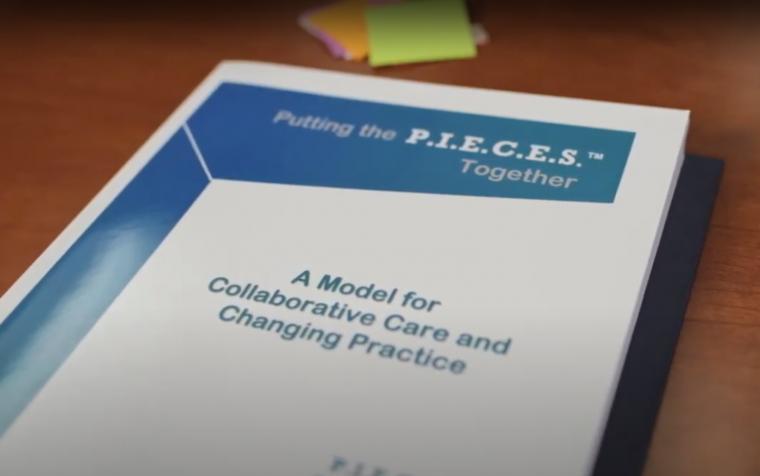As a first year medical student at Queen’s University, Dr Carol Ward’s interaction with an elderly patient named Anna shaped the way she practices geriatric psychiatry.
 “I have a very visual memory,” Dr Ward said, thinking back to that day more than 30 years ago when she went on her first home visit to an apartment in Kingston, Ontario where Anna lived alone. “I can see her, I can see the sun, I can see the light, and remember coming away from that experience with positive feelings that I had connected with her in a meaningful way. It was my ‘a-ha’ moment.”
“I have a very visual memory,” Dr Ward said, thinking back to that day more than 30 years ago when she went on her first home visit to an apartment in Kingston, Ontario where Anna lived alone. “I can see her, I can see the sun, I can see the light, and remember coming away from that experience with positive feelings that I had connected with her in a meaningful way. It was my ‘a-ha’ moment.”
Getting to know Anna as a person — not as a patient — during that visit came naturally to Dr Ward who grew up amidst older members of her extended family in the Maritimes. From them, she’d learned how to connect through stories during day-long lobster boils on the Bay of Fundy. “It takes up an entire afternoon when you talk and eat lobster,” she reminisced. “That was my life growing up; eating and talking and listening to stories.”
Her experiences with Anna and her love of stories combined to inspire her to practice medicine.
Story as the cornerstone of treatment
Dr Ward applies the power of story to help adult and older adult patients navigate their complex mental health challenges at Hillside Centre, a 47-bed tertiary mental health facility in Kamloops BC.
In 2012, Dr Ward and her colleagues adopted P.I.E.C.E.S.TM at Hillside, a model of care that draws on a patient’s story to develop a behavioural care plan that sits at the centre of treatment. The care plan takes the place of the more traditional pharmacological approach to care.
“You hear about drugs and older adults, but how do you convey the non-drug piece? How do you incorporate a person’s story into their treatment?” questioned Dr Ward. “That’s what the behavioural care plan does so well.”
 After success with P.I.E.C.E.S.TM, Dr Ward and her colleagues developed and delivered an accredited workshop for primary care practitioners to spread knowledge of the care model. With funding from the Specialist Services Committee (SSC), a video series titled “Dementia-related Behaviours: Putting It All Together using P.I.E.C.E.S.TM and the BC BPSD Algorithm is now available online. Located on Interior Health’s YouTube channel, the video series shows how to build an effective behavioural care plan and approach to responsive behaviours that fits each unique patient.
After success with P.I.E.C.E.S.TM, Dr Ward and her colleagues developed and delivered an accredited workshop for primary care practitioners to spread knowledge of the care model. With funding from the Specialist Services Committee (SSC), a video series titled “Dementia-related Behaviours: Putting It All Together using P.I.E.C.E.S.TM and the BC BPSD Algorithm is now available online. Located on Interior Health’s YouTube channel, the video series shows how to build an effective behavioural care plan and approach to responsive behaviours that fits each unique patient.
Take, for instance, the example of a 44-year-old patient with Alzheimer’s disease who couldn’t stand still during care and would walk until she fell down. Through P.I.E.C.E.S.TM, the care team discovered that the patient loved pop music. When it played, the patient started singing and was able to stay in one place for long enough to be provided with needed care. The care team also discovered that even though she was no longer talking, she was still able to sing.
To further support P.I.E.C.E.S.TM, Interior Health’s long-term care leadership and Dr Ward also received funding through SSC’s Quality and Innovation fund for a project titled, Enhancing Geriatric Services in Long Term Care. Initially, the two-year pilot project funded 2.5 Regional Knowledge Coordinators- Complex Behaviour - LTC, but the success of the SSC project led to continued funding for four positions.
“The impact of the knowledge coordinators has been quite significant,” Dr Ward said. “They are our first line and teach long term care staff how to write behavioural care plans.”
Bringing it back to story
Although 30 years has passed since Dr Ward encountered Anna, the take-away lingers, serving to remind her of the foundational principle of geriatric psychiatry: Provide care that takes a holistic view of the person and seeks to understand the social as well as the physical.
“When you know someone’s story, you’re better able to tailor your relationship with that person into something that’s meaningful,” she said. “I call it care choreography. This is not easy work. It takes time to understand, to put together, translate, and implement. It’s like a PDSA cycle every time.”
